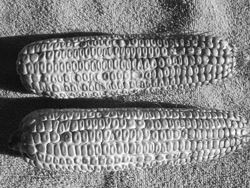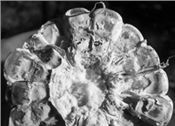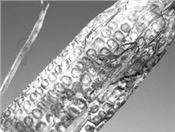Corn Ear Rot Concerns
DR. CARL A. BRADLEY
PRINCETON, KY.
Conditions during July were favorable for infections by a couple of fungi that are known to cause ear rots of corn. Observations of Diplodia ear rot already have been made in some corn fields in Kentucky this year. Although conditions have also been favorable for Gibberella ear rot, I am not aware of any observations of that disease in Kentucky corn fields at this time.
Diplodia Ear Rot
Ears affected by Diplodia may have a white mold growing on and/or between the rows of corn kernels (Figure 1). Ears affected within 2 weeks after silking may be completely “mummified”, while in later infections, a light, cottony growth may be observed growing on the ear. Speck-sized fungal fruiting bodies (pycnidia) will be formed by the Diplodia ear rot fungus (Stenocarpella maydis), and often can be observed on the sides of the kernels (Figure 2). Unlike most other ear rots, Diplodia ear rot typically starts at the base of the ear and continues to develop towards the tip of the ear.
Affected kernels will be lighter in weight than non-affected kernels, thus, overall test weight can be affected. In fields with high levels of ear rot, discounts applied at the elevator can be expected for the presence of damaged kernels. In cases of severe ear rot, the cob may also be rotted, which means that pieces of the cob will not separate well from the grain during harvest. In these cases, additional discounts for the presence of foreign material may also be applied at the elevator. Recent research has shown that some isolates of S. maydis may produce mycotoxins; however, no cases of poisoning of livestock that have eaten S. maydis-infected corn have been reported in North America. If feeding grain from ears affected by Diplodia ear rot, it is important to do so cautiously with attention to how livestock respond. It is also possible that other fungi may colonize ears and kernels affected by Diplodia ear rot, and some of these, like Fusarium, may produce mycotoxins that can affect livestock adversely.
Gibberella Ear Rot
Ears affected by Gibberella rot may have a pink mold growing on the kernels (Figure 3).
Gibberella ear rot generally begins at the tip of the ear, and may be more severe when the husk is damaged by insects, hail, etc. Gibberella ear rot is caused by the same fungus that causes Fusarium head blight (head scab) of wheat and barley (Fusarium graminearum). This fungus can produce mycotoxins, such as deoxynivalenol (DON; vomitoxin) or zearalenone. Before feeding any moldy corn to livestock, it is important to have the grain (or silage) tested for the presence of mycotoxin. A partial list of laboratories that can test for mycotoxins is available here. In addition to potentially being contaminated with mycotoxins, affected kernels also may be lighter in weight.
Harvest & Grain Storage Considerations
To prevent additional fungal growth and disease spread within an ear, it is best to harvest affected fields as soon as possible and dry the grain to below 15.5 percent moisture (or below 13 percent moisture for long-term storage). If you have crop insurance, be sure to contact your agent as soon as possible, as some certain documentation may need to be made for a claim to be filed. Moldy grain should always be tested before being fed to livestock. ∆
DR. CARL A. BRADLEY: Extension Plant Pathologist, University of Kentucky

Figure 1. White, cottony mold beginning at the base of the ear and developing
towards the tip, which is typical of Diplodia ear rot.
Photo: Carl Bradley, UK

Figure 2. Black specks on kernels are fruiting bodies (pycnidia) produced
by the Diplodia ear rot fungus.
Photo: Carl Bradley, UK

Figure 3. Pink-colored mold growing on corn kernels, which is typical of Gibberella ear rot.
Photo: Don White, University of Illinois